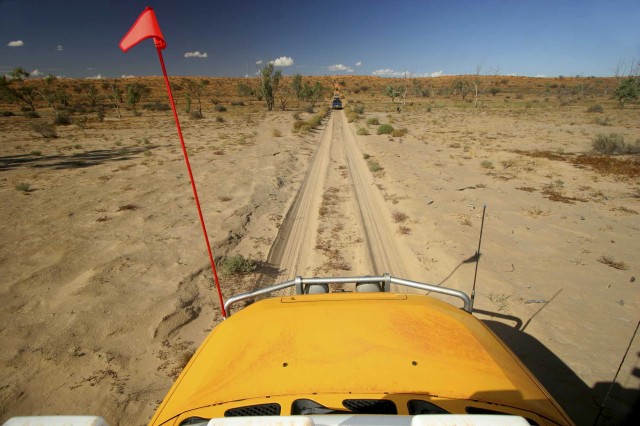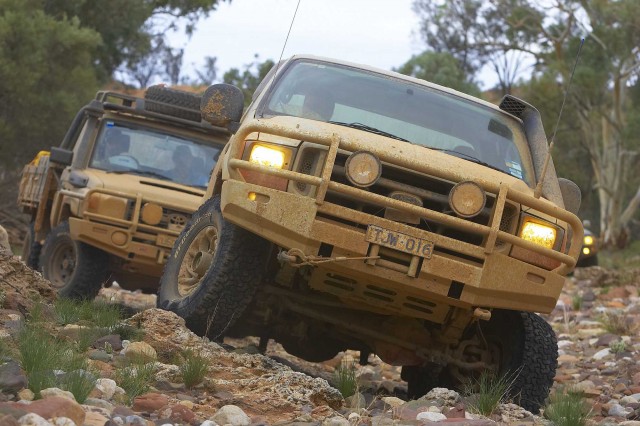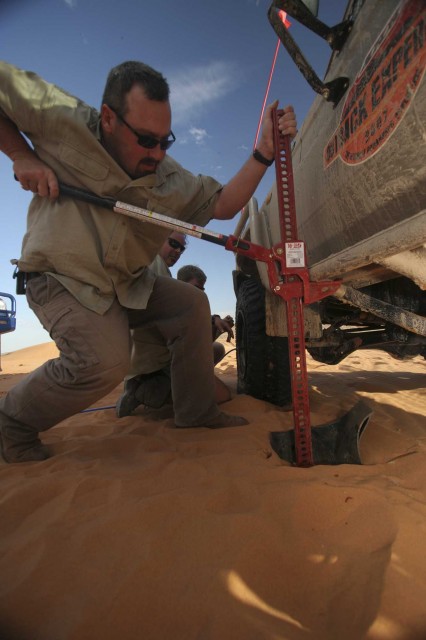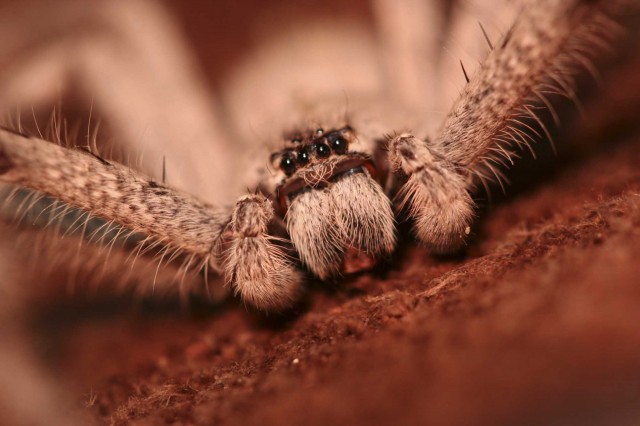G’day mate… ya on ya pat?… Good on ya! Pull a tennie from the esky and join us for some tucker. Ya good on the fang? Take a squiz at the snags on the barbie, no salad pushers here mate.
Ahhh, Australia. It is a place everyone should experience: Australians have a perpetually humorous fashion and a different word for everything. Now let me translate the above greeting for those that are not fluent in Aussie speak.
“Good evening, are you traveling alone? (Aussies like things that rhyme: “pat,” as in Pat Malone, rhymes with alone. So if you are “on your Pat,” then you are traveling alone. Make sense? Not really, but when you pass over the equator heading for the Land Down Under, the world takes on a different look about it. I’ll continue with the translation. “Grab a beer from the ice chest and join us for dinner. Are you hungry? Check out the hot dogs on the BBQ, no vegetarians here ay?
Numerous crumbling remnants of stone ranch houses and outbuilding bore witness to the struggles of early settlers.
From Silverton, a desert as flat and limitless as a russet ocean stretched into the distance. This was Mundi Mundi, a place where the curvature of the earth spills slowly off to the north and south in divided symmetry. (right) Everyone should experience a cold stubbie and the authentic flavor of a true Outback roadhouse.
World’s longest fence, the Australia’s Dingo Fence, runs a distance of 5,614 kilometers from Jimbour in Queensland to the Great Australian Bight.
Australia is home to nine of the worlds ten deadliest snakes. This spotted brown slitered off the road as we approached and quickly disappearing into a hole near some brush.
One of the only perennial sources of water in the region, Cooper Creek was home to the indigenous Yandruwndha people. It was also the base camp for Burks and Wills ill-fated expedition to reach Australia’s Top End. All but one member of the expedition perished.
Each night we tossed back tinnies and had a good chinwag around the fire.
Tucked in between the Coral and Tasman Seas to the east, and the Southern and Indian Oceans to the west, Australia sat alone, “on it’s Pat,” as an ocean island for than a century after the Americas were discovered. It wasn’t until Englishman Capitan James Cook sailed his crippled ship, Endeavor, into a safe harbor at Cooktown in 1770 that Australia was claimed by a European entity. In May of 1787, England dispatched the First Fleet in an attempt to colonize their new acquisition. Early the following spring, a flotilla of 11 ships loaded with livestock, seed, solders, and 736 convicts landed near Sidney on the continents southeast coast. With an overburdened prison system, England had deemed this remote southern island to be the perfect depository for the unwanted dregs of its society. The result was a two-fold win for Britain, alleviating the prison issue and colonizing their empire’s newest acquisition.
It was a prison with 2,000-mile thick walls—the shark-infested waters of the Coral Sea separated Australia’s newest residents from freedom. Upon completion of a sentence of hard labor, if they survived, convicts were given the same rights as solders and 20 hectares of land. At that point, freedom lay on the western horizon, beyond the black swamp. As sentences were carried out, freed ex-cons took advantage of the opportunities of this new and wild land. It is from these arduous and humble beginnings that Australia’s citizenry developed its rough-and-ready, no-nonsense disposition.
The Cordillo Downs Station encompasses almost 8,000 kilometers, larger than the states of Rhode Island and Delaware combined. In its heyday the station ran almost 85,000 sheep and produced some of the highest quality wool in Australia. The sheering shed and a large variety of the original equipment has now been preserved as a museum.
The Birdsville Working Museum (and Leather Factory) holds an amazing collection of gadgets and gizmos things that work.
Silerton has been the site of many movie sets including Mel Gibson’s Mad Max. The car in front of the hotel, a modified GT351 1973 Ford XB Falcon Coupe, is a replica of the original.
By the 1850’s settlers had moved west towards the current port city of Melbourne, and then north into the continents great red center, the Outback. With the vast interior of the continent uncharted, these same hearty individuals homesteaded tracks of land and set the foundation for that would become Australia’s leading exports, textile-quality wool and beef. The overland routes became the economic arteries for the country. They were used to transport supplies in, and cattle and wool out. In an attempt to retrace the wagon tracks and footprints of those intrepid Aussies of yesteryear, we joined the crew from ARB to explore the Land Down Under’s great Outback.
Over the course of 10 days we would cover over 2,000 kilometers of dirt two-tracks, visit cattle stations larger that some U.S. States, and follow the path of the Great Australian Cattle Drive. We would also meet 6th-generation cattle drovers, descendants of the original settlers, and get a taste of the Strzelecki, Sturt Stony, and Simpson Deserts. When the sun set low on the horizon, we would circle the wagons, belly up to the chow wagon, and have a good chinwag around the fire. Our swags rolled out under the under the astral skies, we’d lay back and watch the southern constellations traverse the horizon. This would be an Outback Experience we wouldn’t soon forget.
Go North, Mad Max, Broken Hill and Kangaroos
The pre-dawn light illuminated the horizon as our contingent rolled out of Broken Hill towards Silverton near the Southern Australian border. Broken Hill is home to one of the country’s premiere endurance rally, the Outback Challenge, and the decaying remains of Silverton are better known as the filming location of Mel Gibson’s film Road Warrior.
We had a fleet of ARB’s test vehicles ranging from a right-hand drive Super Duty F-250 and 100 Series Toyota Land Cruiser, to a Jeep Sahara and an FJ Cruiser. All were sporting BFGoodrich tires, and several were fitted with ARB prototype suspensions and shocks. ARB has a long history of extensively field testing its products prior to releasing them to the public. With a group of 13 four-wheel drive journalists from around the world, every bumpstop and rev limiter would be put to the line during the course of the trip.
The tires hummed along a narrow strip of bitumen east of Silverton. At the crest of a hill, a desert as flat and limitless as a russet ocean stretched into the distance for as far as the eye could see. This was Mundi Mundi, where the horizon filleted an unblemished sky like a land-born contrail. We parked and observed the curvature of the earth spilling slowly off to the north and south in divided symmetry. Near the spot where the Mel Gibson flipped his fuel-laden semi into a cloud of red dust, we watched the Never Never come alive.
The bitumen transitioned to dirt as we made the turn to Eldee Station, our first brekkie stop (breakfast). Eldee was one of several dozen stations (Aussie speak for cattle or sheep ranch) we would visit. The Schmidt family, who acquired an Australian Land Grant for the Eldee in the 1920s, has been in the region since the 1860s. Just 55 kilometers from Broken Hill, and with good access to points north, the Eldee is often used as a base camp for the Outback Challenge.
Our destination this day was Cameron Corner at the three-state boundary, and our route would take us through the Barrier Range on the eastern edge of Mundi Mundi. In the arid Outback, the economy and lives of its European settlers often balanced on environmental changes. During spells of drought, the land could support fewer livestock. As economies suffered, many stations closed up shop, the owners giving up land grants and moving to urban areas. The crumbling remnants of numerous stone ranch houses bore witness to the struggles of the regions early residents.
Though seemingly barren and desiccated, the desert supports an abundance of life. A couple of gray kangaroo, referred to as skippies, bounced across the road and into the brush, and wedge tailed eagles cut large crescents above our convoy. Midmorning we stopped at the crossroads of the Paringa and the Silver City Highway (Outback highways are actually graded dirt roads), and experienced a proper British tradition, morning tea and snacks. The cookies for our roundup were Michael and Joanne McCulkin, owners of Tri-State Tours. Michael is an expert on Australia’s flora and fauna, and Joanne’s charge was to keep our posse from starving. On a traditional cattle drive, cookies would ride ahead and scout out a suitable site for meals and camping. We would suffer through this tradition of tea each morning and afternoon (Yes, we have really tough jobs).
Cameron Corner, the Dingo Fence and Birdsville
At the intersection of Southern Australia, New South Wales, and Queensland, lies the Cameron Corner roadhouse. In a world were distances are measure by the number of extra jerry cans you need to carry, Cameron Corner is a necessary fuel stop and a great place to toss back a stubbie (bottle of beer) and grab evening tucker (dinner). Australia’s 5,600-kilometer dingo fence, the longest in the world, passes through the Corner. Built in 1884, it was designed to keep dingos from preying on the cattle and sheep of the southern stations. Following the 29th parallel along the fence, we headed into the Strzelecki Desert and north to Innamincka Station. Innamincka sets on the banks of Cooper Creek, the primary water source for the region and basecamp of the ill-fated Burk and Wills expedition.
As we trekked north the landscape revealed the secrets its geology. Although this is one of the driest regions on the continent, its creeks and riverbeds, which are dry most of the year, have been carved by the raging waters of “the wet.” Camp this night would be several hundred kilometers to the north on the edge of a dry creek near Cordillo Downs Station. Originally homesteaded in 1875, the 7,500-kilometer station ran up to 85,000 sheep and produced some of the countries best wool for export.
The following morning was quite wet and we receive word on the VHF radio that heavy rains had closed several tracks to the north. It seemed that Australia’s 10-year drought might be coming to an end. The Outback is known for its bulldust (red silt). When it rains, bulldust turns to a gooey paste akin to a mixture of clay and oil. It made from some slippery (but really fun) driving conditions. We played a game of high-speed slip-and-slid for several hundred kilometers, which provided an opportunity to put each vehicles stability control system to the test. Unpredictable in nature, the clouds had parted and the Australian sun was again searing our brow by the time we pulled into Birdsville.
Birdsville, the central supply depot for a county with a population of only 326, lies nearly 300 kilometers from its nearest neighbor. It is also home of the famous Birdsville horse races. Originating in 1882, each September the town’s population swells to nearly 6,000 during race week. It also sits on the eastern fringe of the Simpson Desert.
Swinging the double doors open to the Birdsville Hotel, the aura of Australia’s Wild West flooded past us and into the street. With all the appeal of a Southern biker bar (which we like), soiled Akubra hats from long-dead drovers and faded photos of early stationers canvassed the 16-foot stone and stucco walls. Behind the bar, several dozen personalized stubbie holders (for regular patrons) sat next to long rack of draft beer taps. ARB had booked rooms (very cool), and we proceeded to rub elbows and toss back tinnies (beer in a tin can) with the locals and shoot pool under a small squadron of giant moths. It was an authentic Outback roadhouse experience, replete with the late night ruckus of Birdsville’s finest.
Big Red, Simpson Desert, and Submerged Superduties
Shades of magenta illuminated the horizon as the stars yielded to daylight, unveiling a shallow body of water in what is normally a cracked and fissured dry lake. Cattle egrets and white ibis pecked at in the shallows for water bugs that had lay dormant since the last watershed. Our tires dug into the crimson sand as we nosed off the summit of Big Red, the tallest dune in the area (Ok, so only takes five minuets to climb on foot and is 40-meters from top to bottom). So it’s not that tall, but from the top you can see a 100 kilometers into the Simpson. We headed west, following a sandy two-track towards the first of 1,000 north-south dunes. Over the VHF radio we heard reports that the rains had inundated our exit route near Mount Dare with eight feet of water. After 40 kilometers of dunes we would have to return to Birdsville and take an alternative route.
At Eyre Creek the water was about four feet deep, well over the hoods of most of our rigs. In first position was the Toyota 79 Series Land Cruiser pick-up, followed by the 100 Series and the F-250. After the rigs were through, ruts the soft mud bottom were getting deep and we opted to head back to the base of Big Red to camp. The return crossing was not so smooth, and the F-250 found it self in seat-deep swamp water (yes, the seats in the cab). Considering the rig was Andy Brown’s personal rig (one of ARB’s owners) this was a not good.
These were not the places you’ll see if you follow “trip suggestions” in your travel guide. This was beyond the black stump, Back’o Bourke, the Never Never—Aussie terms for the Outback)—and we were diving knee deep into the heart of it.
Join Chris and the ARB posse’s Outback Experience Part II as they explore the Birdsville Track and follow the trail of the Great Australian Cattle Drive.







































